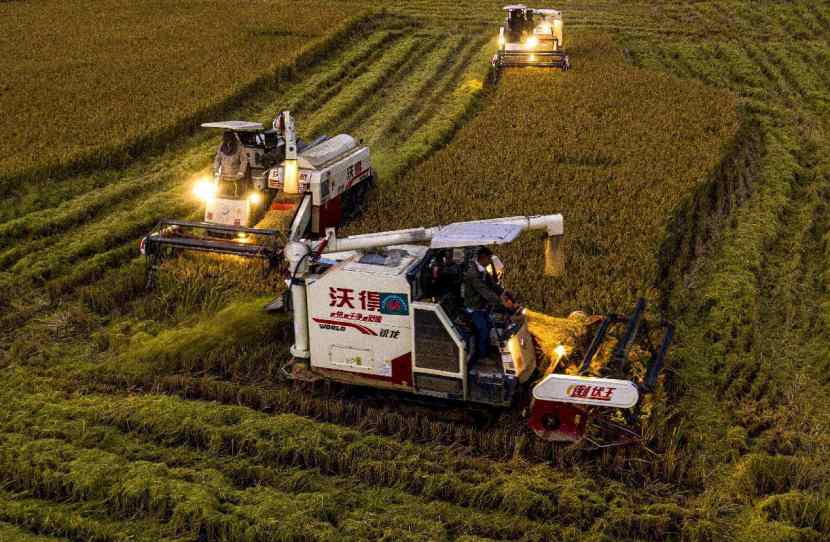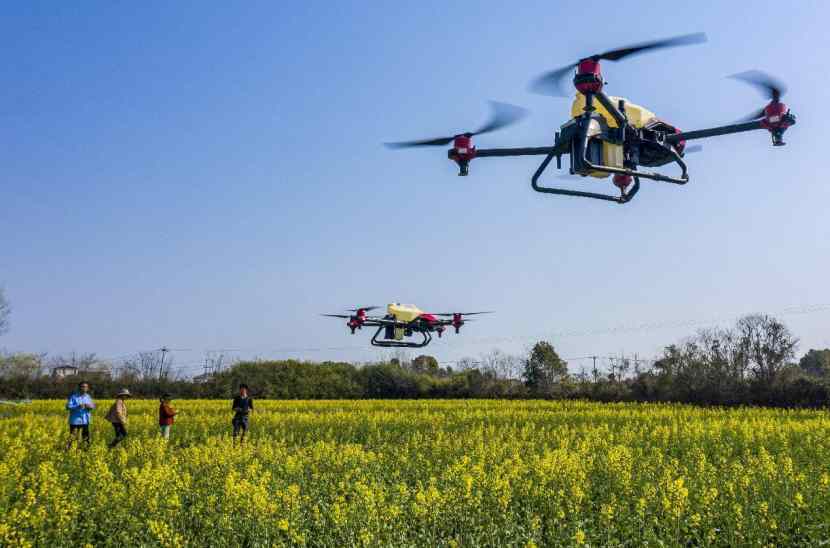‘Farmland nannies’ facilitate agricultural modernization in China
Many Chinese farmers now turn to commercial agricultural service providers or major growers for the management of farmlands they don’t wish to cultivate by themselves. “Farmland nannies”, people who help farmers take care of their farmlands, are playing an increasingly important role in agricultural production across the country.

“Farmland nannies”, people who are hired to tend and manage farmlands for others, harvest rice for a major rice grower with agricultural machinery in Fuhuai village, Leqiao township, Lujiang county, Hefei city, east China’s Anhui province, Oct. 27, 2021. (People’s Daily Online/Zuo Xuechang)
With rural roots, professional skills and advanced equipment, these “farmland nannies” can undertake part or all of the farmland cultivation and management activities for farmers according to their needs.
Some commercial agricultural service providers increase the economic benefits of farmlands by reducing costs through unified cultivation and pest and disease prevention and control operations, while some try to raise the prices of agricultural products by promoting the cultivation of superior varieties, quality improvement, and standardization of production.
“Farmland nannies” not only save time and energy for farmers, but help incorporate smallholder farmers into modern agriculture and stimulate farmlands’ potential for higher yields.
Gu Jingwen, a farmer in Nanyuanzhai village, Feixiang district, Handan city, north China’s Hebei province, is one of the Chinese farmers who have benefited from the innovative “nanny services”.
Since Gu has entrusted the task of tending and managing the 15 mu (1 hectare) of farmlands of his family to a cooperative in his village, he doesn’t need to return home for farm work even during busy farming seasons.
“Hiring ‘nannies’ for crops ensures timely spring farming. They can provide ‘one-stop’ services from sowing and disease and pest prevention and control to management. With the time saved on agricultural labor, I can seek a job in the cities, which can bring me an annual income of 30,000 yuan ($4,488) to 40,000 yuan,” Gu told People’s Daily, adding that the idea of hiring “farmland nannies” is brilliant.

Meng Fanliang (second from right), an agricultural expert, is invited by an agricultural cooperative in Yicheng district, Zaozhuang city, east China’s Shandong province, to teach spring wheat management techniques to local “farmland nannies”, people who are hired to tend and manage farmlands for others, Feb. 28, 2022. (People’s Daily Online/Sun Zhongzhe)
In Nanyuanzhai village, “farmland nannies” tend and manage 3,500 mu of farmlands for more than 200 households. As local farmlands are contiguous with each other, full mechanization of crop production has been realized, saving 80 percent of manual labor for each mu of land and cutting the costs of crop production by more than 30 percent, significantly increasing the economic benefits of crop farming.
In the country with a relatively limited per capita arable land area, the problem of “who farms the land” has caused increasing concerns as many young and middle-aged rural workers leave their hometowns to work in urban areas.
“Farmland nannies” are without doubt a good choice, especially for many rural areas that can neither realize large-scale centralized operations in a short period of time nor pursue a path requiring significant input and high expenditure for the availability of small and complete equipment in every household.
The development of commercial services in the agricultural sector can help introduce advanced and suitable varieties, technologies, equipment, organizational forms, among other modern production factors, and reduce production costs and operational risks, which is critical for boosting agricultural modernization.
Farmers have generally accepted "nanny services" as an essential type of commercial service in the agriculture industry. With obvious advantages in cost reduction and environmental sustainability, such services can effectively overcome the shortcomings of smallholder farmers in decentralized agricultural operations.

A team of “farmland nannies”, people who are hired to tend and manage farmlands for others, carry out disease and pest prevention and control operations in an oilseed rape field of a major grain grower in Zhandian village, Leqiao township, Lujiang county, Hefei city, east China’s Anhui province, March 11, 2022. (People’s Daily Online/ Zuo Xuechang)
“Nanny services” can not only cut the production costs of food crops like wheat and corn, but reduce the usage of fertilizers by about 40 percent and that of pesticides by more than 50 percent by leveraging soil testing and formulated fertilization, green disease and pest prevention and control, as well as other technologies.
Commercial agricultural services in China are still in the initial stage of development. There are currently 955,000 commercial agricultural service organizations in China, which serve about 38.4 percent of the country’s smallholder farmers.
In last July, China’s Ministry of Agriculture and Rural Affairs (MARA) issued a guideline on accelerating the development of commercial agricultural services. According to the document, the country will strive to basically establish a system of commercial agricultural services featuring reasonable organizational structure, high professionalism, strong service capability and standardized services and covering the entire industrial chain through five to 10 years of efforts by vigorously developing diversified, multi-level and multi-type commercial services in the agricultural sector.
In September of the same year, the MARA selected and recognized 30 typical commercial agricultural service providers.
As the providers of commercial agricultural services continue to diversify and their scope of services continues to expand, they will play more important roles and bring tangible benefits to more farmers across the country.
Photos
 China’s central bank to issue commemorative coins on cultural theme of auspiciousness, including two heart-shaped coins
China’s central bank to issue commemorative coins on cultural theme of auspiciousness, including two heart-shaped coins Population of endangered black-headed gulls exceeds 10,000 mark in NE China’s coastal city of Panjin
Population of endangered black-headed gulls exceeds 10,000 mark in NE China’s coastal city of Panjin China's self-developed floating airship breaks record
China's self-developed floating airship breaks record Chinese germplasm bank conserves biodiversity in warm temperate zone
Chinese germplasm bank conserves biodiversity in warm temperate zone
Related Stories
- Steel slag-turned soil conditioner changes saline-alkali land into fertile farmland
- China turns saline-alkali land in Yellow River Delta into high-yield farmland
- China must ensure area of farmland above redline: gov't work report
- China's Taoyuan County steps up high-standard farmland construction
- Farmers enjoy more time for work, leisure after cropland trusteeship program frees them from heavy toil in the fields
- China to add more high-standard farmland by 2030
- Aerial views of farmlands in Jiangxi Province
- China builds over 5.59 mln hectares of high-standard farmland in 2020
- China to stick to strictest farmland protection system: draft outline
- China to return 820,000 hectares of farmlands to forests in 2017
Copyright © 2022 People's Daily Online. All Rights Reserved.






